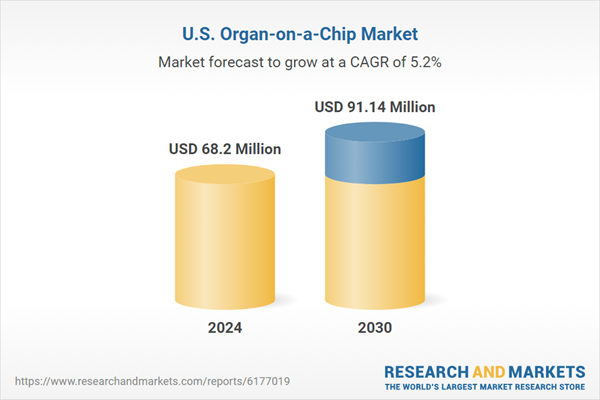Speak directly to the analyst to clarify any post sales queries you may have.
10% Free customizationThis report comes with 10% free customization, enabling you to add data that meets your specific business needs.
Despite its promise, the market is not without challenges. Technical complexity remains a significant barrier, as operating and maintaining these systems requires specialized expertise and infrastructure. In addition, cost considerations and scalability limitations continue to affect their broader implementation, particularly in resource-constrained settings. However, continued investment in automation, standardization, and user-friendly design is expected to gradually mitigate these issues and expand access across the industry.
Key Market Drivers
Growth in Healthcare Industry
The rapid expansion of the healthcare industry in the United States is a key driver fueling the growth of the organ-on-a-chip (OoC) market. Healthcare represents a significant component of national economies, accounting for over 10% of the gross domestic product (GDP) in most developed countries. In the United States, healthcare expenditures increased by 2.7% in 2021, totaling USD 4.3 trillion or approximately USD 12,914 per capita. As healthcare providers, pharmaceutical companies, and research institutions increasingly prioritize personalized medicine, drug development, and predictive toxicology, the demand for advanced in-vitro models such as organ-on-a-chip is surging.In 2022, the United States Congress enacted the FDA Modernization Act 2.0, permitting the use of alternative preclinical testing methods as a substitute for traditional animal testing. The rising focus on improving the efficiency and accuracy of preclinical testing has led to a shift away from traditional animal models, which often fail to replicate human physiological responses. Organ-on-a-chip technologies offer a more reliable and cost-effective alternative by simulating human organ functions on microfluidic devices. This innovation aligns with the broader healthcare industry’s goal of accelerating drug discovery while reducing R&D costs and ethical concerns.
Key Market Challenges
High Costs & Complex Manufacturing
One of the primary challenges facing the United States Organ-on-a-Chip market is the high cost and complexity associated with manufacturing these advanced microfluidic devices. The intricate design and fabrication processes require precision engineering, specialized materials, and sophisticated microfabrication techniques, which collectively contribute to elevated production expenses. These costs extend beyond initial manufacturing to include ongoing maintenance, quality control, and validation efforts, making the overall investment substantial.Moreover, the complexity inherent in producing reliable and reproducible organ-on-a-chip platforms poses significant barriers to scalability and mass production. Each device must meet stringent biological and engineering specifications to accurately mimic human organ functions, demanding multidisciplinary expertise and extensive R&D efforts. This technical sophistication limits the ability of smaller companies and research institutions to independently manufacture these chips, often necessitating partnerships with specialized contract manufacturers or service providers.
Key Market Trends
Rise of Personalized Medicine
The rise of personalized medicine is emerging as a pivotal trend shaping the United States organ-on-a-chip (OoC) market. Personalized medicine, which focuses on tailoring medical treatment to the individual characteristics of each patient, demands highly precise and predictive models to understand patient-specific drug responses and disease mechanisms. Organ-on-a-chip technology addresses this need by replicating the microenvironment of human organs with high fidelity, enabling more accurate simulation of how a particular patient’s cells might react to different therapies.This trend is driven by advancements in genomics, biotechnology, and data analytics, which collectively support the shift towards treatments that are customized rather than one-size-fits-all. The integration of cells from multiple organs within a single chip enables a more holistic approach to drug screening, toxicology assessment, biomarker identification, cancer research, and disease modeling, including Parkinson’s disease. The broad range of available cell lines provides substantial flexibility in selecting the most suitable research materials. Organ-on-a-chip devices facilitate this by providing platforms where patient-derived cells can be cultured to test drug efficacy and toxicity on a personalized level, thereby minimizing adverse effects and improving therapeutic outcomes.
Key Market Players
- Emulate, Inc.
- MIMETAS B.V.
- Valo Health
- Quris Technologies LTD.
- AxoSim
- BICO - THE BIO CONVERGENCE COMPANY
- CN Bio Innovations Ltd
- The Charles Stark Draper Laboratory, Inc.
- SynVivo, Inc.
- AlveoliX AG
Report Scope
In this report, the United States Organ-on-a-Chip Market has been segmented into the following categories, in addition to the industry trends which have also been detailed below:United States Organ-on-a-Chip Market, By Device:
- Liver-on-a-Chip
- Lung-on-a-Chip
- Intestine-on-a-Chip
- Kidney-on-a-Chip
- Heart-on-a-Chip
- Others
United States Organ-on-a-Chip Market, By Application:
- Drug Discovery
- Toxicology Research
- Others
United States Organ-on-a-Chip Market, By Region:
- Northeast
- Midwest
- South
- West
Competitive Landscape
Company Profiles: Detailed analysis of the major companies present in the United States Organ-on-a-Chip Market.Available Customizations:
With the given market data, the publisher offers customizations according to a company's specific needs. The following customization options are available for the report.Company Information
- Detailed analysis and profiling of additional market players (up to five).
This product will be delivered within 1-3 business days.
Table of Contents
Companies Mentioned
- Emulate, Inc.
- MIMETAS B.V.
- Valo Health
- Quris Technologies LTD.
- AxoSim
- BICO - THE BIO CONVERGENCE COMPANY
- CN Bio Innovations Ltd
- The Charles Stark Draper Laboratory, Inc.
- SynVivo, Inc.
- AlveoliX AG
Table Information
| Report Attribute | Details |
|---|---|
| No. of Pages | 85 |
| Published | September 2025 |
| Forecast Period | 2024 - 2030 |
| Estimated Market Value ( USD | $ 68.2 Million |
| Forecasted Market Value ( USD | $ 91.14 Million |
| Compound Annual Growth Rate | 5.1% |
| Regions Covered | United States |
| No. of Companies Mentioned | 10 |









